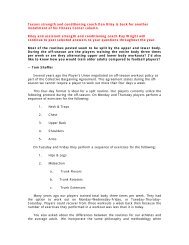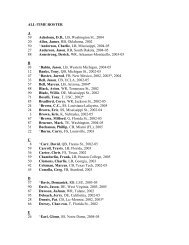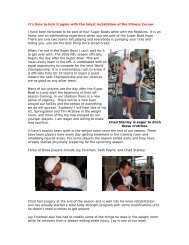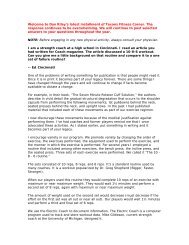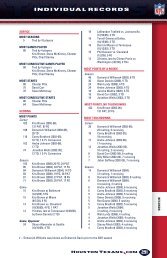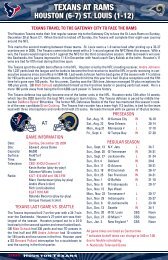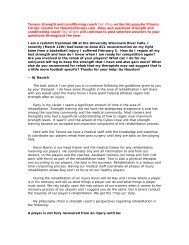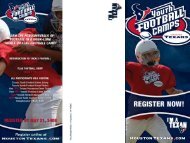Welcome to Dan Riley's latest installment of Texans Fitness Corner ...
Welcome to Dan Riley's latest installment of Texans Fitness Corner ...
Welcome to Dan Riley's latest installment of Texans Fitness Corner ...
You also want an ePaper? Increase the reach of your titles
YUMPU automatically turns print PDFs into web optimized ePapers that Google loves.
<strong>Welcome</strong> <strong>to</strong> <strong>Dan</strong> Riley’s <strong>latest</strong> <strong>installment</strong> <strong>of</strong> <strong>Texans</strong> <strong>Fitness</strong> <strong>Corner</strong>. The<br />
response continues <strong>to</strong> be overwhelming. We will continue <strong>to</strong> post selected<br />
answers <strong>to</strong> your questions throughout the year.<br />
NOTE: Before engaging in any new physical activity, always consult your physician.<br />
I am a new <strong>of</strong>fensive line coach for the Munich Rangers, located in Munich,<br />
Germany. What specific strength and conditioning routines do you<br />
recommend for <strong>of</strong>fensive linemen that are different from the other<br />
positions<br />
-- Coach Thomas Grimm<br />
Congratulations on your new position. You have the same last name as current NFL<br />
O-line coach Russ Grimm. I have known Russ for 20 years. During my career with<br />
the Redskins I was fortunate <strong>to</strong> have the opportunity <strong>to</strong> work with Russ during his<br />
stellar 11-year career as an NFL <strong>of</strong>fensive lineman.<br />
Russ has been nominated for induction in<strong>to</strong> the National Football League Hall <strong>of</strong><br />
Fame. After retiring as a player, Russ coached the <strong>of</strong>fensive line for the Skins. He is<br />
currently coaching the O-line for the Pittsburgh Steelers. Russ is recognized as one<br />
<strong>of</strong> the most eminently qualified coaches in the League and is destined <strong>to</strong> become a<br />
head coach in the near future.<br />
One <strong>of</strong> my most fond memories <strong>of</strong> Russ is the confrontations he used <strong>to</strong> have with<br />
Randy White each time we played the Cowboys. Russ played left guard and lined up<br />
over Randy. He was responsible for blocking him on most plays. There was little<br />
conversation between the two but there was mutual respect.<br />
There was a third party that always created a bigger problem for Russ. That third<br />
party was Mark May (current ESPN announcer). Mark (nickname is Mayday) played<br />
right tackle and didn’t have <strong>to</strong> block Randy. He and Randy didn’t get along <strong>to</strong>o well<br />
on the field. They were constantly exchanging expletives.<br />
During one game our <strong>of</strong>fense was in the huddle with Joe Theismann trying <strong>to</strong> call a<br />
play. While in the huddle Mark had turned around and was pointing and screaming at<br />
Randy (with Randy screaming back). Russ was screaming at Mark <strong>to</strong> shut up or<br />
come and play left guard.<br />
When they came <strong>of</strong>f the field Mark was laughing because he had Randy and Russ<br />
mad at him. Russ was screaming at Mark telling him <strong>to</strong> shut his mouth because he<br />
was getting Randy riled up and making it harder for Russ. Mark said, “Sure Russ,<br />
whatever you say.”<br />
The next series Mark shoved Randy in the back and a brawl erupted. You gotta love<br />
that Mayday.<br />
Enough talk about Coach Grimm <strong>of</strong> the Steelers, let’s talk about Coach Grimm <strong>of</strong> the<br />
Rangers, and the strength and conditioning program for your linemen.
Carter Toole is the Direc<strong>to</strong>r <strong>of</strong> our <strong>Texans</strong> website. He receives the questions for the<br />
<strong>Fitness</strong> <strong>Corner</strong> and passes them on <strong>to</strong> me. Your question is a good one but<br />
somewhat general in nature. I’ll do my best <strong>to</strong> answer your question in the space<br />
available.<br />
I would also suggest you <strong>to</strong> refer <strong>to</strong> past <strong>installment</strong>s <strong>of</strong> the <strong>Fitness</strong> <strong>Corner</strong> for<br />
additional information. Carter has s<strong>to</strong>red our past <strong>Fitness</strong> <strong>Corner</strong> <strong>installment</strong>s in the<br />
link titled, <strong>Fitness</strong> <strong>Corner</strong> Archive. It is located at the end <strong>of</strong> this <strong>installment</strong>.<br />
The strength and conditioning pr<strong>of</strong>ile for our Hous<strong>to</strong>n <strong>Texans</strong> (and your Munich<br />
Rangers) will incorporate seven basic components. Each component must be<br />
addressed individually. The seven components include the following:<br />
Strength and ConditioningPr<strong>of</strong>ile for the Hous<strong>to</strong>n <strong>Texans</strong><br />
· Nutrition<br />
· Muscular <strong>Fitness</strong><br />
· Flexibility<br />
· Conditioning<br />
· Specific Speed & Quickness Training<br />
· Skill Development<br />
· Rest<br />
All <strong>of</strong> our players will utilize the same training pro<strong>to</strong>col for each <strong>of</strong> the components<br />
listed above, except for Specific Speed & Quickness Training and Skill Development.<br />
The Mo<strong>to</strong>r Learning Community agrees that Skill Development is very specific.<br />
Athletes must practice the exact skills they use <strong>to</strong> play the game <strong>to</strong> refine those<br />
specific skills. It’s almost impossible <strong>to</strong> duplicate any <strong>of</strong> those skills in the weight<br />
room unless you clear an area and have your players put on the pads and scrimmage<br />
at full speed. Skills are specific. Don’t try <strong>to</strong> imitate football skills in the weight room.<br />
It can’t be done.<br />
I’m not a football coach. I can’t advise you on how <strong>to</strong> improve the skills used <strong>to</strong> play<br />
<strong>of</strong>fensive line. I’d recommend you exchange ideas with other <strong>of</strong>fensive line coaches<br />
for this information.<br />
I can tell you that the transfer <strong>of</strong> skill from one task <strong>to</strong> another (task <strong>to</strong> task<br />
transfer) is almost non-existent. For example, the skills used <strong>to</strong> jump rope will not<br />
transfer <strong>to</strong> the skills used <strong>to</strong> pass protect. The message is, whenever possible<br />
practice the exact skills your players will use in a game.<br />
Sage states, “Studies <strong>of</strong> mo<strong>to</strong>r skill transfer from one task <strong>to</strong> another are not<br />
numerous but they do consistently support the notion that there is little transfer
from one task <strong>to</strong> another. In summarizing data on task-<strong>to</strong>-task transfer with mo<strong>to</strong>r<br />
tasks it appears that there is little transfer <strong>of</strong> any kind.”<br />
Therefore don’t waste valuable time and energy practicing skills that aren’t specific<br />
<strong>to</strong> the exact task at hand.<br />
Intra-task transfer is a term used by mo<strong>to</strong>r-learning experts <strong>to</strong> describe several<br />
tasks performed in sequence <strong>to</strong> complete a skill. Transfer does take place with intratask<br />
transfer.<br />
I have observed Russ Grimm coach the <strong>of</strong>fensive line by having them (from their<br />
stance) practice their first step only. Over and over, the linemen would practice<br />
taking their first step. He would then have them practice hand placement, followed<br />
by a second step. Each task was practiced individually and eventually put <strong>to</strong>gether<br />
and practiced from beginning <strong>to</strong> end at full speed.<br />
Each <strong>of</strong> these individual tasks when practiced individually will transfer <strong>to</strong> the whole<br />
task at hand. This is called intra-task transfer. My only advice regarding skill<br />
development is <strong>to</strong> have your <strong>of</strong>fensive linemen spend as much time as possible on<br />
the exact skills they will use <strong>to</strong> play the game. The same is true for all positions.<br />
Specific Speed and Quickness is the other fitness component we individualize by<br />
position. The best way (and the only way) <strong>to</strong> develop and maintain the specific<br />
fitness levels used <strong>to</strong> play the game <strong>of</strong> football is <strong>to</strong> eventually play the game <strong>of</strong><br />
football at game speed. We can’t create the intensity <strong>of</strong> game like conditions (an<br />
opponent, specta<strong>to</strong>rs, television coverage, etc., speed <strong>of</strong> the game) in our <strong>of</strong>f-season<br />
conditioning program.<br />
Specificity <strong>of</strong> conditioning is a term we use <strong>to</strong> describe the specific adaptations that<br />
take place physically from an exercise or activity. Conditioning is very specific. The<br />
energy demands used <strong>to</strong> run block and pass protect are different than the specific<br />
energy demands used <strong>to</strong> run in a straight line.<br />
Our <strong>of</strong>f-season running and conditioning program is designed <strong>to</strong> target the energy<br />
systems our players use <strong>to</strong> play football. Our goal is <strong>to</strong> get them in good enough<br />
shape <strong>to</strong> go <strong>to</strong> summer camp and use football <strong>to</strong> get them in shape <strong>to</strong> play the game<br />
<strong>of</strong> football.<br />
The only way <strong>to</strong> develop the exact level <strong>of</strong> conditioning needed <strong>to</strong> play the game <strong>of</strong><br />
football is actually play the game <strong>of</strong> football. It’s unrealistic <strong>to</strong> expect our players <strong>to</strong><br />
play football all year in an attempt <strong>to</strong> stay in football shape.<br />
During the <strong>of</strong>f-season all <strong>of</strong> our players (<strong>to</strong> include our <strong>of</strong>fensive linemen) utilize the<br />
same conditioning and running regimen. Several weeks before going <strong>to</strong> summer<br />
camp we encourage our players <strong>to</strong> implement position specific conditioning drills we<br />
call, “Skilled Pattern Running.” These conditioning patterns are specific <strong>to</strong> each<br />
position. If your players had wet paint on their shoes while playing a game, you<br />
could observe the specific tracking patterns each position player uses during a game.
Skilled pattern running (SPR) is an attempt <strong>to</strong> duplicate some <strong>of</strong> the position specific<br />
patterns performed on the field. It is our last attempt before going <strong>to</strong> summer camp,<br />
<strong>to</strong> prepare our players for the specific physical demands <strong>of</strong> their position.<br />
There are some basic running patterns associated with each position. SPR is an<br />
attempt <strong>to</strong> imitate these basic patterns. I also use SPR during the season <strong>to</strong><br />
complete the rehab process if a player is returning from an injury. Below is the<br />
description <strong>of</strong> SPR that we give <strong>to</strong> our players.<br />
Skilled Pattern Running<br />
Equipment Used: football field/open grass area.<br />
Exercise time: time used <strong>to</strong> complete one pattern<br />
Rest interval: time used <strong>to</strong> jog back <strong>to</strong> the starting position<br />
Number <strong>of</strong> reps: 10<br />
Rest between sets: 1 1/2 - 2 1/2 minutes<br />
Two significant benefits can be obtained from using SPR. First, you begin <strong>to</strong><br />
familiarize the neuromuscular system with the position specific drills you will use<br />
when you report <strong>to</strong> camp. Second, it can be used as a conditioning <strong>to</strong>ol for the heart<br />
and lungs, as well as your muscular system. The time <strong>to</strong> begin skilled pattern<br />
running is several weeks before reporting <strong>to</strong> summer camp.<br />
We’ve organized these skill patterns in<strong>to</strong> a series <strong>of</strong> ten different routes. From a<br />
designated starting point perform the first skill pattern all out and slowly jog back <strong>to</strong><br />
the starting point. Immediately perform the second skill pattern and again jog back<br />
<strong>to</strong> the starting point. Continue this process until each <strong>of</strong> the ten skill patterns has<br />
been executed.<br />
This completes the first set <strong>of</strong> your skilled pattern running. Perform three <strong>to</strong> five sets<br />
<strong>of</strong> ten different skill patterns. The rest interval between each set will be dependent<br />
upon your fitness level. A minimum <strong>of</strong> 1 1/2 minutes <strong>to</strong> a maximum <strong>of</strong> 3 minutes<br />
recovery time should be allowed between sets. Perform each pattern all out and pay<br />
attention <strong>to</strong> detail regarding any specific techniques emphasized by your position<br />
coach.<br />
Several players can run the skill patterns in succession. The first player runs a skill<br />
pattern. While he jogs back <strong>to</strong> the starting position a second, third, and fourth player<br />
can immediately run the pattern in succession.<br />
Coach Grimm, I suggest you provide your players with a diagram <strong>of</strong> each <strong>of</strong> your<br />
patterns (originating from the same starting position). You can laminate the sheet <strong>of</strong><br />
paper for protection. Give copies <strong>to</strong> your players. If it is large enough the athletes<br />
can set the diagram on the ground at the starting point and use it as a reference.<br />
Another option is <strong>to</strong> make it small enough <strong>to</strong> hold in the palm <strong>of</strong> the hand and give<br />
one <strong>to</strong> each player.
A brief description <strong>of</strong> each pattern is listed below. The patterns will change by<br />
position but the administration will remain the same.<br />
OFFENSIVE LINE SKILL PATTERNS<br />
NumberPattern Description<br />
1. sprint 10 yards -- sprint straight ahead 10 yards pushing <strong>of</strong>f left foot<br />
2. sprint 10 yards -- sprint straight ahead 10 yards pushing <strong>of</strong>f right foot<br />
3. 45-degree start -- start pushing <strong>of</strong>f with left foot and sprint 10 yards at a 45-<br />
degree angle<br />
4. 45-degree start -- same as above but start pushing <strong>of</strong>f with right foot<br />
5. pull right -- pull right with first step a drop step with right foot and whip right arm<br />
<strong>of</strong>f right foot and sprint parallel <strong>to</strong> L.O.S. 10 yards and sprint up field 5 yards.<br />
6. pull left -- same as above but pull left and whip left arm<br />
7. pass set -- take pass set <strong>of</strong>f ball (7steps) and sprint 10 yards up field 5 yards<br />
8. pass set -- take pass set at L.O.S. & hold for a count <strong>of</strong> 1001, 1002, then sprint the L.O.S.<br />
10 yards <strong>to</strong> the right and up field 5 yards<br />
9. pass set -- same as above but <strong>to</strong> the left<br />
10. sweep drill right -- lose 1 ½ yards turn right and sprint the L.O.S. 10 yards then turn up<br />
field and block outside support<br />
11. sweep drill left -- same as above but turn left<br />
12. backpedal -- come out <strong>of</strong> stance take a pass set and backpedal 10 yards<br />
Perform each set all out and allow three minutes recovery between each skill set. Cool down<br />
and stretch after completing skill set #3. As fitness levels improve you can decrease recovery<br />
time.<br />
Skill Set # 1: 1, 2, 3, 4, 5, 6,7, 8, 9, 12<br />
Skill Set # 2: 5, 6, 7, 8, 9, 10, 11, 3, 4, 12<br />
Skill Set # 3: 11, 10, 9, 8, 7, 6, 5, 4, 3, 12
Each set should be performed as a 10-play drive. Finish <strong>of</strong>f each pattern and jog slowly back<br />
<strong>to</strong> the huddle (starting point). Have your linemen warm up and be ready <strong>to</strong> perform each <strong>of</strong><br />
the patterns at game speed.<br />
We administer the same strength program <strong>to</strong> all <strong>of</strong> our players. Our two primary strength<br />
program objectives are:<br />
1. Primary objective must be <strong>to</strong> prevent injury.<br />
2. Enhance the abilities used <strong>to</strong> play the game.<br />
Our basic training philosophy incorporates the following criteria:<br />
1. Develop <strong>to</strong>tal body strength.<br />
2. Neck muscles must be the number one priority.<br />
3. Place an equal emphasis on all other exercises.<br />
4. In-season training is the period <strong>of</strong> priority.<br />
5. Eliminate non-productive exercise - perform as little exercise as needed <strong>to</strong> produce the best<br />
results.<br />
6. Perform both multi-joint and isolation exercises.<br />
7. Keep accurate records.<br />
8. Incorporate variety - perform a variety <strong>of</strong> different exercises and use all types <strong>of</strong> equipment<br />
<strong>to</strong> include barbells, dumbbells, machines, bodyweight, and manual resistance.<br />
Conclusion:<br />
Coach Grimm, on behalf <strong>to</strong> the Hous<strong>to</strong>n <strong>Texans</strong>, best <strong>of</strong> luck this season with the Munich<br />
Rangers. Go <strong>Texans</strong>!<br />
References: Riley, <strong>Dan</strong>, Arap<strong>of</strong>f, Jason, Washing<strong>to</strong>n Redskins Strength & Conditioning Manual,<br />
Spring 2000.



